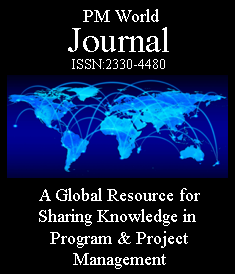Best Practices, Emerging Trends
and Strategic Approaches
FEATURED PAPER
By Prof. Dr. M.F. HARAKE
CEREGE Research Laboratory
University of Poitiers (France)
Abstract
In today’s rapidly evolving digital landscape, cybersecurity has emerged as a critical concern for organizations across all sectors. As businesses increasingly rely on interconnected systems, cloud technologies, and digital transformation, cybersecurity is no longer just a specialized IT function but a central responsibility integrated into the core of project management. This paper explores the intersection of cybersecurity and project management, examining how cybersecurity can be effectively embedded throughout the project lifecycle to safeguard digital assets, ensure compliance, and support business goals. The paper begins by highlighting the evolving role of cybersecurity in modern organizations. As digital infrastructures become more complex and cyber threats grow increasingly sophisticated, the need for proactive cybersecurity measures is paramount. Project managers, who traditionally focused on scope, time, and budget, must now account for cybersecurity at every stage of a project. This shift requires a deeper understanding of emerging threats, regulatory landscapes, and the tools needed to mitigate risks without stifling innovation or business growth. The integration of cybersecurity frameworks, into project management methodologies is discussed as a critical best practice for managing risks effectively. By embedding security into the project’s design and execution from the outset, organizations can reduce vulnerabilities and ensure the confidentiality, integrity, and availability of sensitive data. Security by design is emphasized as a proactive approach to mitigating risks, rather than a reactive response after issues arise. Furthermore, the paper addresses the emerging trends that are reshaping cybersecurity project management. These include the increasing adoption of cloud services, the integration of artificial intelligence (AI) and machine learning (ML) for real-time threat detection, and the transition to zero-trust security models. Each of these technologies offers unique advantages in improving security but also presents new challenges for project managers who must integrate them into their projects. The rise of blockchain technology and the potential impact of quantum computing on traditional encryption methods are also explored as long-term considerations for cybersecurity. The paper also examines the strategic role of cybersecurity project managers in aligning security initiatives with broader business objectives. As organizations view cybersecurity as a competitive advantage, project managers must ensure that security efforts support digital innovation, regulatory compliance, and customer trust. Effective collaboration with cross-functional teams, including IT, legal, compliance, and business leadership, is essential for ensuring that security is a key consideration in organizational decision-making. Finally, the paper presents practical best practices for cybersecurity project management. These include conducting comprehensive risk assessments, fostering a security-first culture within the organization, continuously monitoring for emerging threats, and ensuring strong vendor and third-party risk management. The integration of agile methodologies is also discussed as a means to stay responsive to rapidly changing threats and business needs. In conclusion, the paper emphasizes that cybersecurity project management is no longer an ancillary concern but a critical component of organizational strategy. By embracing a proactive, integrated approach to cybersecurity, project managers can ensure the successful delivery of secure, resilient, and compliant projects that drive business growth while safeguarding against an increasingly complex and evolving cyber threat landscape.
Key Words: Cybersecurity; Project Management; Risk Management; Security by Design; Emerging Technologies; Compliance; Agile Methodology; Zero-Trust Security.
- Introduction
1.1Overview of Cybersecurity in the Digital Era
In today’s rapidly evolving digital landscape, cybersecurity has become a critical priority for organizations across all sectors. As businesses and governments increasingly depend on interconnected devices, cloud services, and emerging technologies, they face heightened risks of cyberattacks and data breaches (Schneier, 2018). These evolving threats not only jeopardize sensitive information but also undermine organizational trust, compliance with regulatory frameworks, and business continuity (Mallick & Nath, 2024). As digital infrastructure grows more complex, the need for robust cybersecurity measures is more essential than ever before (Haber & Zarsky, 2016).
At the same time, the importance of cybersecurity is no longer confined to IT departments. It has shifted into a cross-functional responsibility that impacts every aspect of organizational operations (Mızrak, 2023). Project management, once primarily concerned with delivering projects on time and within budget, must now integrate cybersecurity as a core component of every phase—from initiation through execution to closure (Atoum et al., 2014). This integration ensures that cybersecurity risks are systematically identified and mitigated throughout the project lifecycle, securing both the project’s deliverables and the organization’s broader strategic goals (Syed Murtaza et al., 2024; ISACA, 2024).
This evolving relationship between cybersecurity and project management reflects the critical role that cybersecurity now plays in ensuring not just the security of digital assets, but also the resilience of entire organizations (Ahmadi-Assalemi et al., 2020). In this context, cybersecurity is no longer an afterthought but a foundational element of every project, woven into the very fabric of business strategy and operations (Möller, 2023).
More…
To read entire paper, click here
How to cite this work: Harake, M. F. (2025). Integrating Cybersecurity into Project Management: Best Practices, Emerging Trends, and Strategic Approaches, PM World Journal, Vol. XIV, Issue I, January. Available online at https://pmworldlibrary.net/wp-content/uploads/2025/01/pmwj148-Jan2025-Harake-Integrating-Cybersecurity-into-Project-Management.pdf
About the Author

Prof. Dr. M. F. HARAKE
Poitiers, France
![]()
Prof. Dr. M. F. HARAKE is a management Professor based in France. He is currently affiliated with CEREGE Research Laboratory at the University of Poitiers (France), and a visiting research fellow at CABMR Research Center (Paris – France). He is also an Honorary Academic Advisor and Research Scholar for the PM Library (Texas – USA). His research interests include Post-Conflict Public Management, Crisis and Urgent Operations Management, Humanitarian Logistics, and Project Management in Unstable Environments.
He can be contacted at mohamed.fadl.harake@univ-poitiers.fr









